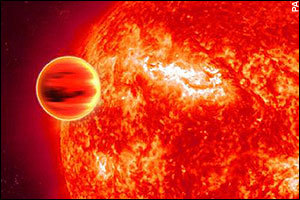The discovery - by Nasa's Spitzer Space Telescope - provide the most convincing evidence yet that water, which is synonymous with the possibility of life, is common elsewhere in the cosmos.
The wet planet is known as HD 189733b, and orbits a star in the constellation of Vulpecula the Fox, which is 64 light years (380 million million miles) from the Sun.
The alien world passes directly in front of its star, as viewed from the Earth, enabling astronomers to analyse its chemical makeup
Astronomers had predicted that planets of this class, termed "hot Jupiters," would contain water vapour in their atmospheres. Yet finding solid evidence for this has been difficult.

|
| ©PA |
| This planet absorbs starlight in a way that can only be explained by the presence of water vapour. |
The researchers, led by Dr Giovanna Tinetti of the European Space Agency and University College London, found that as HD 189733b passes in front of its local star, it absorbs starlight in a way that can only be explained by the presence of water vapour.
The water detection relied not only on Dr Tinetti's painstaking analysis, but also on the calculation of how infrared light would be absorbed by the water.
These latest data, gathered by the orbiting space telescope, are the most convincing yet that hot Jupiters are "wet."
"We're thrilled to have identified clear signs of water on a planet that is trillions of miles away," said Dr Tinetti, a European Space Agency fellow at the Institute d'Astrophysique de Paris in France, and lead author of the study published today in Nature.
Previous measurements from Spitzer reveal HD 189733b is a fiery 730 deg C (1,340 degrees Fahrenheit) on average, and 15 per cent bigger than our own Jupiter.
"If life were there, it would be steamed," Dr Tinetti said.
"The temperature is impractical and being a big gaseous planet, the thought of life on it seems unlikely."
Ultimately, astronomers hope to use instruments like those on Spitzer to find water on rocky, habitable planets like Earth.
"Although HD 189733b is far from being habitable, and actually provides a rather hostile environment, our discovery shows that water might be more common out there than previously thought, and our method can be used in the future to study more 'life-friendly' environments."
Dr Tinetti added: "The 'holy grail' for today's planet hunters is to find an Earth-like planet that also has water in its atmosphere. When it happens, that discovery will provide real evidence that planets outside our Solar System might harbour life. Finding the existence of water on an extra-solar gas giant is a vital milestone along that road of discovery."
Co-author Sean Carey, of the Spitzer Science Centre at the California Institute of Technology, Pasadena, added: "Finding water on this planet implies that other planets in the universe, possibly even rocky ones, could also have water."
The new findings are part of a brand new field of science investigating the climate on exoplanets, or planets outside our solar system.
So far, more than 200 have been found, mostly large planets similar to our own Jupiter.
Such faraway planets cannot be seen directly, even if much bigger than our own Earth. However, in the past few years, astronomers have begun to glean information about their atmospheres by observing a subset of hot Jupiters that transit, or pass in front of, their stars as seen from Earth.



Reader Comments
to our Newsletter